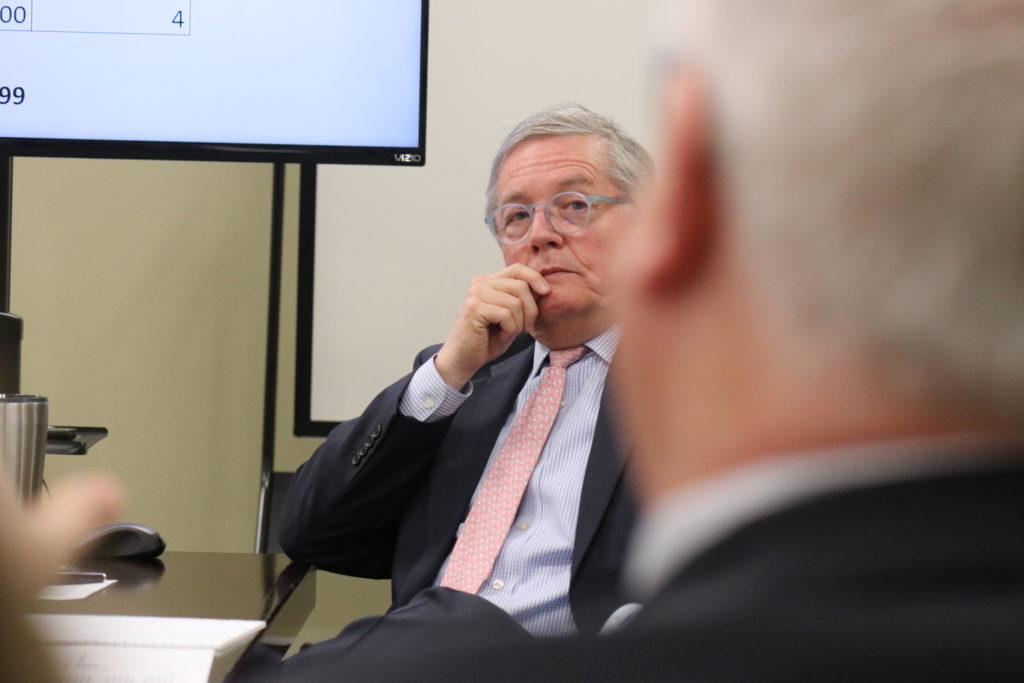
William Ray, GEPB superintendent and engineer, listens during an earlier meeting of the Glasgow Electric Plant Board on Tuesday, Jan. 28, 2020.
(BRENNAN CRAIN/WCLU NEWS)
GLASGOW, Ky. – Members of the Glasgow Electric Plant Board voted Tuesday evening to send a proposed rate structure to the Tennessee Valley Authority that shifts the utility’s rate structure back to a volumetric model.
The GEPB voted in 2014 to end the volumetric model, which meant the utility’s electric rates were based on consumer consumption rather than an average of all electricity consumed by customers. That model shifted to what is now in play, which is called infotricity.
William Ray, the GEPB’s chief engineer and superintendent, told the board that the rate was changed six years ago, and enacted five years ago, because they felt fixed fees were “problematic.”
“Volume was collapsing,” Ray said. “Collecting fixed fees through volume looked like a problematic future. And I just want to remind you, that future has panned out.”
Much of the unrest in Glasgow has resulted from the infotricity model, which is a non-volumetric rate structure. Ratepayers’ bills are made up of one customer fee and an electricity consumption charge that reflects their individual consumption – not an average of all customers.
The motion passed on Tuesday charges the TVA with developing a “harder look” at the feasibility of parting ways with the infotricity model, which would ultimately eliminate “peak” hours and lower the customer charge for residential and commercial customers.
DT Froedge, board member, proposed a new rate structure that includes a $10 flat fee for residential customers and a $20 fee for commercial customers.
Kilowatt-hour costs would be volumetric and flat, with no peak, and no time-of-use based charged.
Also in the proposal were the following:
Price per kWh would be determined by dividing the costs of all residential and commercial customer charges by the sum of the kW hours used by commercial and residential customers.
The monthly rate would be set and stabilized by a running average over three or four months.
There should be no net increase in total costs.
Industrial KW power costs are not to be subsidized by commercial or residential costs.
The GEPB has seen a steady decrease in kW sales, which means the customer charge has historically increased each year to “bridge the gap” in the decreasing kW wholesale rate and the customers’ consumption.
The current model projects that the GEPB could essentially break-even by increasing only the customer fee by 2023. That’s with the current decrease in the kW unit price.
Thus far, 68% of residential customers choose the variable rate, which is 3,846 customers compared to 1,836 that pay the GEPB’s flat-rate fee without peak demand.
The numbers are similar for small commercial customers. Around 80% pay the variable price, which means only 20% elect to not have peak demand charges.
Only 18% of the total customer base chooses to prepay their bill. The iPay method, which enables consumers “to pay as they go” has recovered about $135,000 in lost revenue.
Because the GEPB is not for profit, the sales of electricity and charges to customers are only used to “break even.” Thus, the relationship between the customer charge and electricity sales is inversely related.
The proposed option, developed by the GEPB staff, raises the customer charge to $39.44 per month, which accounts for 70% of the GEPB’s expenses. That means only 20% of the fixed costs must be covered by electricity sales.
With Froedge’s proposal, the customer charge decreases, but the revenue is then dependent on 70% of the electricity sales. As the model has shown, kW sales have decreased dramatically in the last eight years – even before infotricity was adopted.
In a letter on Wednesday to Ernie Peters, a TVA representative, Ray asked TVA to consider the GEPB’s proposal rather than the proposal put forth by Froedge, and a majority of the board.
“We ask that you consider Exhibit B [Ray’s proposal] options, even though they did not get approval from the Board,” Ray wrote.
The letter came after the board meeting. But Ray also insisted the Board adopt the rate structure he proposed because it’s the most transparent and a cost-based model, which means customers pay the GEPB the price it takes to connect them to the electric grid and serve that electricity to them.
Ray argued that Froedge’s model was actually a description of what is in play currently, but Froedge insisted the current rate structure is unfair.
“I wish I could get you to hear me or I wish you would come down and spend some more time until you get it, but we’re talking about the same thing,” Ray said. “I’m convinced of that.”
Ray also asked that a response be delivered before a mediation meeting on Oct. 20 of the GEPB. Froedge later emailed Peters and opposed Ray’s suggestion.
The GEPB rate structure is updated annually on Jan. 1.





